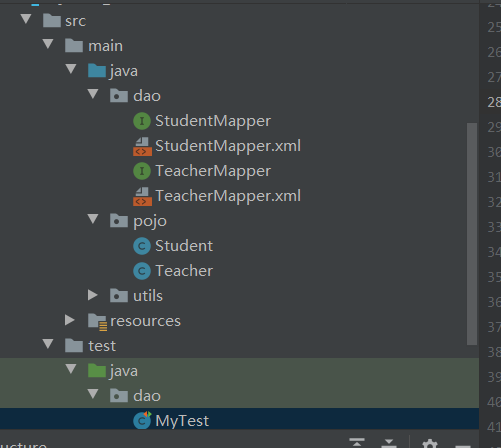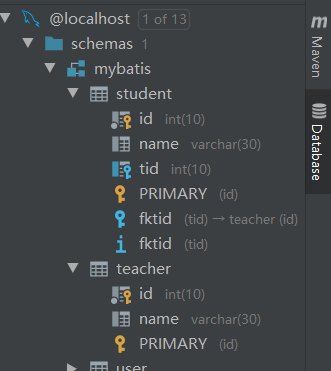

TeacherMapper.java
package dao; import org.apache.ibatis.annotations.Param; import org.apache.ibatis.annotations.Select; import pojo.Teacher; import java.util.List; public interface TeacherMapper { //test环境 // public List<Teacher> getTeacher(); //获取指定老师下的学生 public Teacher getTeacher(@Param("tid") int id); public Teacher getTeacher2(@Param("tid") int id); }
TeacherMapper.xml
<?xml version="1.0" encoding="UTF-8" ?> <!DOCTYPE mapper PUBLIC "-//mybatis.org//DTD Mapper 3.0//EN" "http://mybatis.org/dtd/mybatis-3-mapper.dtd"> <!--namespace=绑定一个对应的Dao/Mapper接口--> <mapper namespace="dao.TeacherMapper"> <!--第一种--> <!--按结果嵌套查询--> <resultMap id="TS" type="Teacher"> <result property="id" column="tid"/> <result property="name" column="tname"/> <!--一对多使用collection--> <!--集合使用ofType--> <collection property="student" ofType="Student"> <result property="id" column="sid"/> <result property="name" column="sname"/> <result property="tid" column="tid"/> </collection> </resultMap> <select id="getTeacher" resultMap="TS"> select s.id sid,s.name sname,t.name tname,t.id tid from student s,teacher t where s.tid=t.id and t.id=#{tid} </select> <!--==================================================--> <resultMap id="TS2" type="Teacher"> <collection property="student" javaType="ArrayList" ofType="Student" select="getStudent" column="id"> </collection> </resultMap> <select id="getTeacher2" resultMap="TS2"> select * from teacher where id = #{tid} </select> <select id="getStudent" resultType="Student"> select * from student where tid = #{id} </select> </mapper>
MyTset.java
package dao; import org.apache.ibatis.session.SqlSession; import org.junit.Test; import pojo.Teacher; import utils.MybatisUtils; import java.util.List; public class MyTest { @Test public void getTeacher() { SqlSession sqlSession= MybatisUtils.getSqlSession(); TeacherMapper teacherMapper=sqlSession.getMapper(TeacherMapper.class); Teacher teacher=teacherMapper.getTeacher(1); System.out.println(teacher); sqlSession.close(); } @Test public void getTeacher2() { SqlSession sqlSession= MybatisUtils.getSqlSession(); TeacherMapper teacherMapper=sqlSession.getMapper(TeacherMapper.class); Teacher teacher=teacherMapper.getTeacher2(1); System.out.println(teacher); sqlSession.close(); } }

今天的第一种和昨天的第二种是同一类型的查询方式,个人比较喜欢第二种,喜欢SQL语句复杂一些,而不是套娃复杂一些